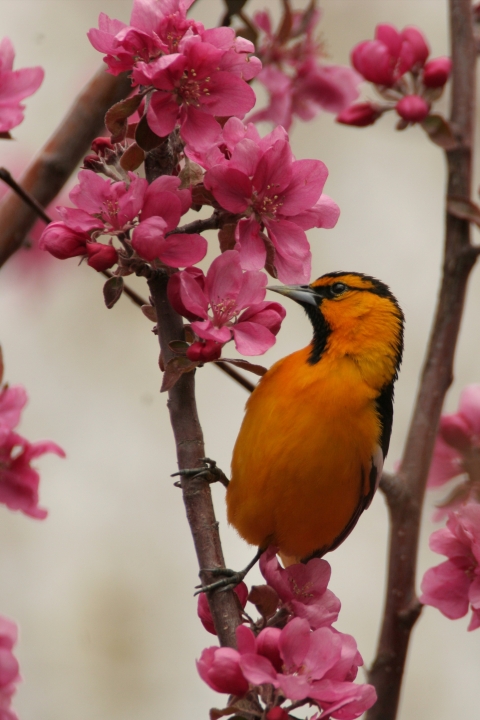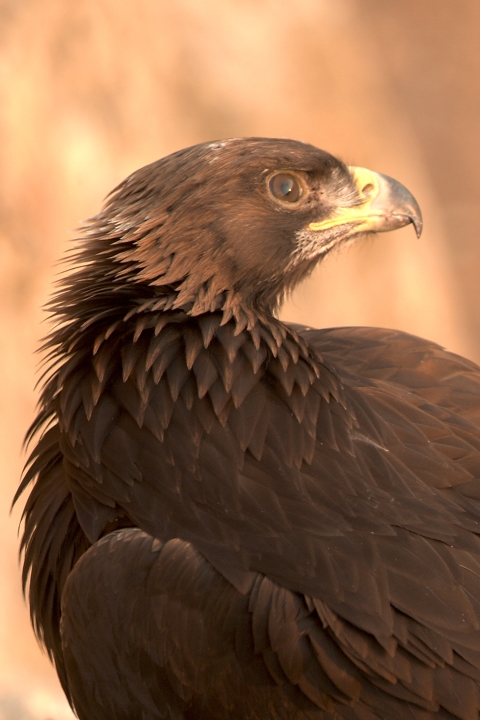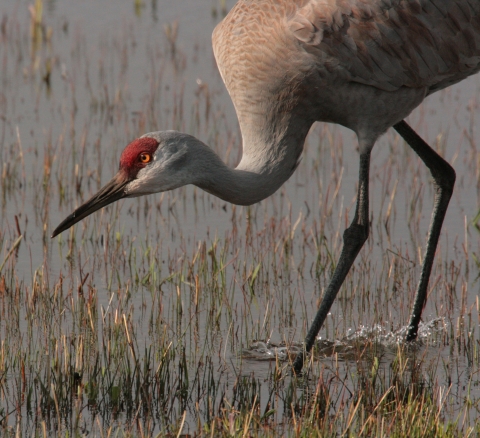Seasons of Wildlife
Malheur National Wildlife Refuge is famous for its spectacular concentrations of wildlife, which are attracted to the Refuge’s habitats and abundant water resources in an otherwise arid landscape. With more than 340 bird species and 67 mammal species, there is always something to see at Malheur. The greatest variety of waterfowl and songbirds can be found on the Refuge from late winter through the end of May. The abundance of species varies by the seasons, as you will see by the available Watchable Wildlife Brochure and the Refuge’s Average Early Arrival Dates for migratory species if you come in spring with particular species in mind. Discover a new world of birding with eBirdat Malheur National Wildlife Refuge and other areas. eBird transforms your bird sightings into science and conservation.
The following chronology of the seasons will help you decide When To Visit. Scroll down to learn a little more about When to Visit - SEASONS, MALHEUR'S FEATURED SPECIES, and MALHEUR'S SPECIES LIST.
When to Visit
Early morning and late evening are the best times to observe wildlife. Binoculars and spotting scopes are encouraged to allow you to get a closer look without leaving your vehicle. Your vehicle is an excellent observation and photographic blind. Please stay in your vehicle if possible to avoid scaring wildlife. Be considerate and bird from the curb – the next visitors will appreciate it.
Spring (March-May)
Spring provides a wide variety of wildlife viewing opportunities on the Refuge. Birds are in fresh plumage and engaged in public display. Large flocks of some species make spectacular appearances in the newly wet meadows, which brings many species out in the open.
Elegant northern pintails, greater and lesser sandhill cranes dancing in meadows, and brilliant songbirds provide ample viewing and photography opportunities for visitors to the Refuge. Migratory waterfowl and shorebirds begin arriving in late winter and songbirds wait until later in the spring to arrive, so timing your visit is critical in the spring.
Summer (June-August)
Nesting birds quietly move around the Refuge as spring turns to summer. Ducklings and goslings can be found in abundance in ponds and wetlands in the Blitzen Valley. Southbound shorebirds begin arriving in July from their high-latitude breeding grounds to fuel up for their extended journey south.
The Double-O unit of the Refuge and Harney, Mud, and Malheur Lakes provide excellent feeding for shorebirds on receding mudflats and alkali playas. Least and western sandpipers and both species of yellowlegs are common. Unusual shorebird species to watch for include solitary, pectoral, and Baird's sandpipers, as well as, marbled godwit and ruddy turnstone.
Fall (September-November)
The quiet of summer is broken by the arrival of lesser and greater sandhill cranes feasting on grain fields scattered throughout the Refuge. Migratory waterfowl numbers are low as the area tends to be dry and waterfowl stay farther west of the Harney Basin on their southward migration. Songbirds return and provide ample viewing opportunities - testing bird-watching skills as juveniles mix with adults.
Winter (December-February)
Warblers have gone south for the winter, but some sparrows remain. Careful observers may find American tree sparrows along snow-lined roads, and if they are lucky, longspurs or snow buntings.
Many species of raptors, ducks, geese, and swans use the Refuge in winter, but their numbers are reduced compared to other times of the year, because of cold temperatures and few areas of open water. Check Marshall Pond at Headquarters, the Blitzen River, Benson Pond, Knox Pond, and the Narrows Pullout. Search for Barrow's and common goldeneyes, and mergansers, as well as, the rare Eurasian widgeon.
One of the highlights of winter is large groups of tundra swans which may be present in October and November at Knox Pond, Benson Pond, and Marshall Pond. Hundreds can gather in one area and their voices carry long distances. Resident trumpeter swans may also be seen. Both species of swans may remain through the winter but in smaller numbers.
Featured Species
Malheur National Wildlife Refuge was established in 1908 to protect migratory waterfowl, with an emphasis on colonial nesting species. Today, the Refuge encompasses over 187,000 acres that is disproportionately important as a stop along the Pacific Flyway, and as resting, breeding and nesting area for hundreds of thousands of migratory birds and other wildlife. Many of the species migrating through or breeding at Malheur are highlighted as priority species in national bird conservation plans.
Historical bird counts show that the Refuge and the Silvies River floodplain just north of the Refuge may support anywhere between 5 and 66 percent of the Pacific Flyway’s migrating populations for various priority waterfowl. On the Refuge, breeding habitat is significant for waterbirds, with the Refuge currently supporting over 20 percent of the Oregon population of breeding greater sandhill cranes. Most colonial waterbird numbers have easily exceeded 10 percent of the regional population at peak, even reaching up to 77 percent of the Great Basin population for certain species. Numbers of migrating shorebirds have been documented at levels high enough to qualify the Refuge as a Regional Western Hemispheric Shorebird Reserve. The Refuge also supports very high densities of certain nesting riparian riparian
Definition of riparian habitat or riparian areas.
Learn more about riparian passerines and the largest local population of bobolinks in the western U.S.
Malheur's Species List
See our species list at Watchable Wildlife Brochure and the Refuge’s Average Early Arrival Dates for migratory species if you come in spring with particular species in mind. Discover a new world of birding with eBirdat Malheur National Wildlife Refuge and other areas. eBird transforms your bird sightings into science and conservation.






